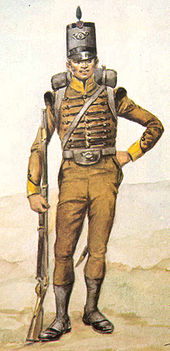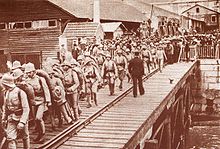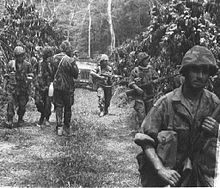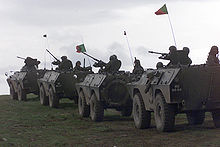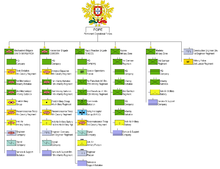- Portuguese Army
-
Portuguese Army
Exército Português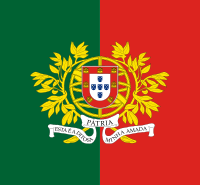
War flag of the Portuguese ArmyActive 1139 — current Country Portugal Type Army Role Land Force Size 24,000 Part of Portuguese Armed Forces Patron Afonso I of Portugal Motto Em perigos e guerras esforçados
In dangers and wars strengthenedEngagements Reconquista
1383–1385 Crisis
War of the Castilian Succession
Persia–Portugal war
Ethiopian-Adal War
Dutch–Portuguese War
Turkish-Portuguese Wars
War of the Portuguese Succession
Malayan-Portuguese War
Portuguese Restoration War
War of the Spanish Succession
Seven Years' War
French Revolutionary Wars
War of the Oranges
Peninsular War
Luso-Brazilian invasion
Liberal Wars
First Carlist War
World War I
Portuguese-Indian War (1961)
Portuguese Colonial War
IFOR
SFOR
EUFOR
KFOR
Afghanistan War
Peacekeaping Missions
-Angola
-Bosnia
-Croatia
-Macedonia
-Western Sahara
-Georgia
-LebanonCommanders Army Chief of Staff General José Luís Pinto Ramalho Portuguese Army Chaimite armoured vehicles in Bosnia.
The Portuguese Army (Portuguese: Exército Português) is the ground branch of the Portuguese Armed Forces which, in co-operation with other branches of the Portuguese military, is charged with the defence of Portugal. It is one of the oldest armies in the world, established in the 12th century.
Contents
History
The history of the Portuguese Army is directly connected to the history of Portugal.
National defence
The land forces fought for Portuguese independence against the Leonese and the Moors in the 12th century, against the Castilian invaders in the 14th century, against the Spanish Habsburgs in the 17th century, and against French invaders in the Peninsular War in the 19th century. Here they were re-trained by the British (under the direction of Lieutenant General William Carr Beresford). Their infantry and artillery went on to perform brilliantly up until the final French capitulation in 1814.
Foreign campaigns
Since the 15th century, the land forces have also participated in Portuguese foreign and overseas campaigns — in Africa, Asia, the Americas, Oceania, and Europe. In the 20th century, the Portuguese Expeditionary Corps participated in World War I on the side of the Allies in the European western front and Africa.
Colonial War
The army participated in colonial war from 1961 to 1974, in Angola, Goa, Mozambique, Portuguese Guinea and Cape Verde. At the other oversees possessions, East Timor and São Tomé and Príncipe, there was a military presence but no guerrilla organizations. In 1961, the isolated and relatively small Portuguese Army suffered a defeat against a largely superior Indian Army in the colony of Portuguese India, which was subsequently lost to the Union of India in the same invasion. The counterinsurgency campaigns in Africa had various degrees of success ranging from almost victory in Angola to total and conventional war in Portuguese Guinea. This war ended after the Carnation Revolution military coup of April 1974 in Lisbon and subsequently independence of the colonies.
European/NATO focus
After the independence of the colonies and the normalization of Portuguese political affairs the Portuguese army returned to the barracks and began the process of changing from an oversized colonial and counter-insurgency army to a conventional European army, including drastic personnel reduction, disbanding of some units, acquisition of new arms and equipment, reorganizing units and roles, fielding new headquarters and becoming fully professional. These took several decades and the defined purposes and roles have somehow changed due to external causes like the end of the Cold War as well internal causes like available budget, political changes and the acceptance and desires of the Portuguese people regarding its armed forces.
Peace missions
In the 21st century, the Portuguese Army has participated in several peace missions, including in Bosnia and Herzegovina, Kosovo, East-Timor, and Afghanistan — where it has a Comandos company deployed. In December 2005, a Portuguese commando died in an incident in Afghanistan when a bomb trap was detonated.
Order of battle
Central structure
The Portuguese Army is led by the Army Chief of Staff and includes:
- Army Staff ;
- Functional Commands:
- Training and Doctrine Command
- Logistical Command
- Personnel Command
- Operational Command
- Operational Formations and Military Zones:
- Rapid Reaction Brigade
- Mechanized Brigade
- Intervention Brigade
- Military Zone of Azores,
- Military Zone of Madeira
- Main Military Schools:
- Military Academy
- Army Sergeant School
- School of the Military Medical Service
- Army Polytechnical School
Base units
The Portuguese Army Base Structure Units work as administrative bases responsible for the training and organization of
the operational units of the army's formations, military zones and general support forces. For historical reasons most of the base units are called regiments and are associated with an arm of service. By arm of service, these units are:- Cavalry:
- School of Cavalry at Abrantes,
- 2nd Lancers Regiment (Army Military Police Unit) at Lisbon
- 3rd Cavalry Regiment at Estremoz
- Cavalry Barracks (former 4th Cavalry Regiment) at Santa Margarida Military Camp
- 6th Cavalry Regiment at Braga
- Artillery:
- School of Artillery at Vendas Novas,
- 1st Anti-Aircraft Artillery Regiment at Queluz
- 4th Artillery Regiment at Leiria
- 5th Artillery Regiment at Vila Nova de Gaia
- Infantry:
- School of Infantry at Mafra
- 1st Infantry Regiment at Tavira
- 3rd Infantry Regiment at Beja
- 8th Infantry Regiment at Elvas (Disbanded: Replaced by a Military Museum)
- 10th Infantry Regiment at Aveiro
- 13th Infantry Regiment at Vila Real
- 14th Infantry Regiment at Viseu
- 15th Infantry Regiment at Tomar
- 19th Infantry Regiment at Chaves
- Engineers:
- Communications:
- School of Communications at Oporto
- Communications Regiment at Lisbon
- Logistical Services:
- School of Services at Póvoa de Varzim
- Medical Service Battalion at Coimbra
- Transportation Regiment at Lisbon
- Maintenance (Material Service) Regiment at Entroncamento
- Mixed:
- Special Operations Troops Centre at Lamego
- Commando Troops Center at Carregueira
- Parachute Troops School at Tancos
- Military Center of Electronics at Paço de Arcos
- 1st Garrison Regiment at Angra do Heroismo
- 2nd Garrison Regiment at Ponta Delgada
- 3rd Garrison Regiment at Funchal
- Intelligence and Military Security Center at Porto Brandão
- Army Light Aviation Unit at Tancos
Ranks
General officers Marechal do Exército
Marshal of the ArmyGeneral
GeneralTenente-general
Lieutenant-generalMajor-general
Major-generalBrigadeiro-general
Brigadier-generalOF-10 OF-9 OF-8 OF-7 OF-6 




Field officers Coronel
ColonelTenente-coronel
Lieutenant-colonelMajor
MajorOF-5 OF-4 OF-3 


Company officers Capitão
CaptainTenente
LieutenantAlferes
EnsignAspirante a oficial
Officer candidateOF-2 OF-1 OF-1 OF-D 



Non-commissioned officers Sargento-mor
Sergeant-majorSargento-chefe
Chief Master SergeantSargento-ajudante
Master sergeantPrimeiro-sargento
First sergeantSegundo-sargento
Second sergeantFurriel
QuartermasterSegundo-furriel
Second quartermasterOR-9 OR-8 OR-7 OR-6 OR-5 OR-5 OR-5 






Enlisted Cabo-adjunto
Attached corporalPrimeiro-cabo
First corporalSegundo-cabo
Second corporalSoldado
SoldierOR-4 OR-3 OR-2 OR-1 Equipment
Firearms
Handguns
- Walther P38
- SIG P228
- Heckler & Koch USP9
Rifles and Carbines
- Heckler & Koch G3 m/61 (standard-issue battle rifle, long due to be replaced)
- Heckler & Koch G36 (chosen to replace G3 in 2006, but not scheluded to do so ever in the future)
- Heckler & Koch HK 417 assault rifle (used as a marksman rifle)
- IMI Galil ARM m/94 Assault Rifle (Paratroopers standard rifle)
- SIG SG 543 Assault Rifle
- Heckler & Koch MSG-90
- AI AWSF m/96
- AI AWSM .338 Lapua Magnum
- AI AW50
- Barrett M95
- Barrett M82A1
Sub-machineguns
- Brügger & Thomet MP9 (sidearm)
- Heckler & Koch MP5K
- Heckler & Koch MP5A5
- Heckler & Koch MP5SD6 (Since 2003)
- IMI Uzi (Being phased out)
Shotguns
- Mossberg 500
- Benelli M3
- Franchi SPAS 15
Light machine guns/General-purpose machine guns
- MG3
- Heckler & Koch HK 21 general-purpose machine gun
- FN Minimi general-purpose machine gun
- Heckler & Koch MG4 general-purpose machine gun
Heavy machineguns
Grenade Launchers
- HK79 (under barrel grenade launcher for G3)
- M203 (under barrel grenade launcher)
- Heckler & Koch AG36 (under barrel grenade launcher for G36)
- ARWEN 37
- Milkor MGL Mk.1
Mortars
- 120mm Tampella B m/74 heavy mortar
- 81mm L16 A2 m/86 medium mortar
- 60mm Soltam light mortar
- 60mm FBP m/68 ultra-light mortar (morteirete)
Missile Launchers
- M72 LAW m/78
- Carl Gustav M3
- MILAN Anti-tank weapon
- TOW Missile launcher
Tanks
- Leopard 2A6 (37)
- M-60 A3TTS (100, to be retired).
Artillery
- 105mm L118 Light Gun (21)
- 105mm M119 Light Gun m/98
- 105mm OTO Melara Mod 56 (discontinued, some may be used by the School of Artillery for no-live fire training, replaced by M119 Light Gun)
- 105mm M101 (discontinued, some may be used by the School of Artillery for no-live fire training)
- 155mm M114 (discontinued, some may be used by the School of Artillery for no-live fire training)
- 155mm M109A5 (18) and M109A4 (??)
Anti-Air Artillery
- Stinger surface-to-air missile
- M48A2E1 Chaparral m/90 surface-to-air missile system
- Double 20mm Reinmetall Rh-202 m/81 anti-aircraft gun
- Bofors 40 mm gun
- 20 mm Vulcan gun M163 Vulcan SPAAG
Tactical Vehicles
- 4x4 Toyota Land Cruiser m/98,
- 4x4 Land Rover Defender'90 TDI;
- 4x4 Mitsubishi L200;
- 4x4 UMM Alter
Heavy Vehicles
Armour
- M48 AVLB Armoured vehicle-launched bridge
- M88 ARV Armoured recovery vehicle
- M901A1 ITV Armoured vehicle ATGMs-launcher
- M113A3 m/76 APC
- Pandur II m/07 APC
- Commando V150 m/89 Armoured car
- Chaimite m/67 APC
- Panhard M11 m/89 Light Armoured car
- HMMWV M1025 m/00;
Helicopters
- NHI NH90 TTH (10 in order)
Others
- PASGT
- DPM Camouflage
- AN/PPS-5B Radar
- Precision Lightweight GPS Receiver (AN/PSN-11 PLGR)
- AN/PVS-5B Night Googles
- AN/MPQ-49B Radar
See also
- Military history of Portugal
- Portuguese Military Academy
- Army Commandos
- Army Special Operations
- Parachute Troops School
- Rapid Reaction Brigade
References
- Jornal do Exército, official magazine
- http://www.defencetalk.com/portuguese-army-once-more-wants-the-ec635t1-helicopter-2586/
External links
- Exército Português, official website
under the command of the Ministry of DefenceArmies (land forces) in Europe Sovereign
states- Albania
- Andorra
- Armenia
- Austria
- Azerbaijan
- Belarus
- Belgium
- Bosnia and Herzegovina
- Bulgaria
- Croatia
- Cyprus
- Czech Republic
- Denmark
- Estonia
- Finland
- France
- Georgia
- Germany
- Greece
- Hungary
- Iceland
- Ireland
- Italy
- Kazakhstan
- Latvia
- Liechtenstein
- Lithuania
- Luxembourg
- Macedonia
- Malta
- Moldova
- Monaco
- Montenegro
- Netherlands
- Norway
- Poland
- Portugal
- Romania
- Russia
- San Marino
- Serbia
- Slovakia
- Slovenia
- Spain
- Sweden
- Switzerland
- Turkey
- Ukraine
- United Kingdom
- Vatican City
States with limited
recognition- Abkhazia
- Kosovo
- Nagorno-Karabakh Republic
- Northern Cyprus
- South Ossetia
- Transnistria
Categories:
Wikimedia Foundation. 2010.

